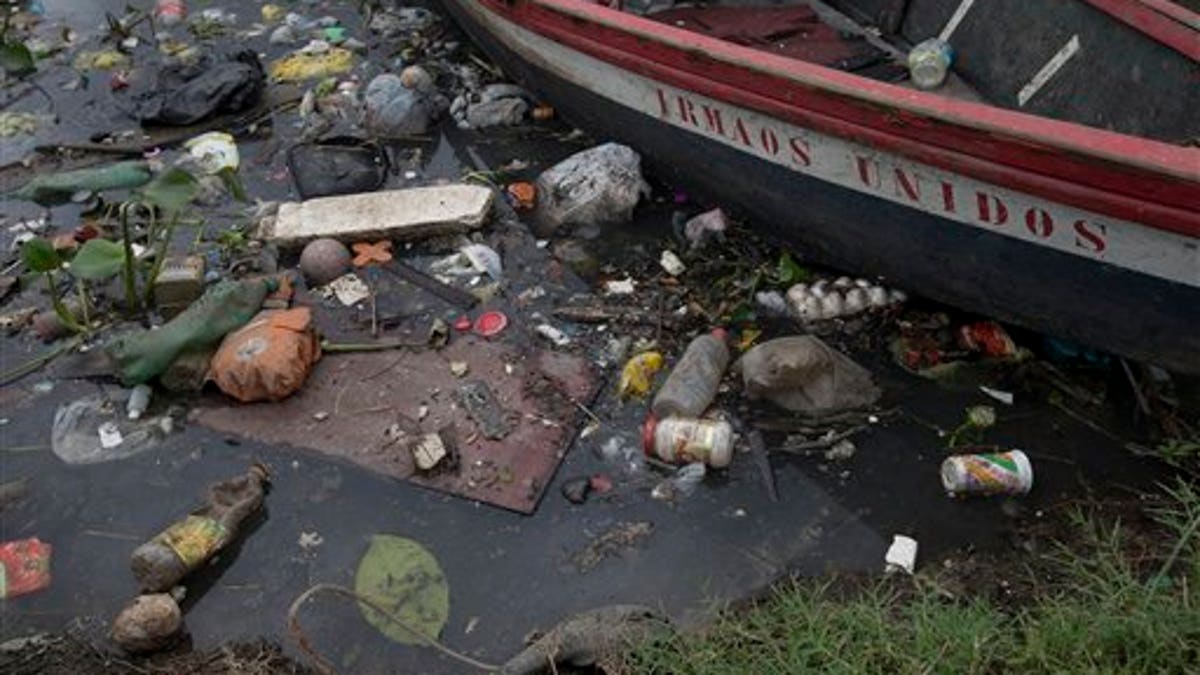
Trash surrounds a boat docked on the banks of the Meriti River, which flows into Guanabara Bay in Rio de Janeiro, Brazil, in November 2015. (AP Photo/Silvia Izquierdo)
RIO DE JANEIRO – The Olympic waters in this city are more widely contaminated by sewage than previously known and pose a greater threat to athletes' health ahead of next year's games, according to new results from tests commissioned by The Associated Press.
Expanded analysis of Rio's waterways shows that high viral and in some cases bacterial counts are found not just along shorelines where raw sewage runs into waterbodies, but far offshore where athletes will compete in sailing, rowing and canoeing.
That means there is no dilution factor in the bay or lagoon where events will take place.
"It's going to increase the exposure of the people who come into contact with those waters," said Kristina Mena, a U.S. expert in waterborne viruses. "If we saw those levels here in the United States on beaches, officials would likely close those beaches."
In July, the AP reported that its first round of tests showed viruses causing stomach and respiratory illnesses and more rarely heart and brain inflammation at levels up to 1.7 million times what would be considered highly alarming in the U.S. or Europe.
The report prompted sports officials to promise they would do their own viral testing. Those pledges took on further urgency in August, after pre-Olympic rowing and sailing events in Rio led to illnesses among athletes nearly double the acceptable limit in the U.S.
"If we saw those levels here in the United States on beaches, officials would likely close those beaches."
Nevertheless, Olympic and World Health Organization officials have flip-flopped on promises to carry out their own viral testing in the wake of the AP's July report.
At issue are two kinds of testing.
Brazilian, Olympic and WHO officials now say Brazil needs only to conduct testing for bacterial "markers" of pollution to determine water quality. That's the standard for nations around the globe to monitor waterbodies, mostly because it's been historically easier and cheaper.
"The health and safety of athletes is always a top priority and there is no doubt that water within the field of play meets the relevant standards," the Rio 2016 Olympic organizing committee said in an emailed statement Tuesday. "Rio 2016 follows the expert advice of the World Health Organization, whose guidelines for Safe Recreational Water Environments recommend classifying water through a regular program of microbial water quality testing."
However, in recent years technological advances have made it simpler and less expensive to monitor viral levels, too.
Studies dating back decades have shown little to no correlation between the levels of bacteria pathogens in water, which quickly break down in salty and sunny conditions like those in tropical Brazil, and the presence of viruses, which have been shown to last for months, and in some cases years.
Rio's waterways, like those of many developing nations, are extremely contaminated because most of the city's sewage is untreated, flowing into Guanabara Bay, the Rodrigo Freitas Lagoon and the famous Copacabana Beach.
Rio won the right to host the Olympics based on a lengthy bid document that promised to clean up the city's scenic waterways by improving sewage sanitation, a pledge that was intended to be one of the event's biggest legacies.
Brazilian officials now acknowledge that won't happen.
The AP's first published results were based on samples taken along the shores of the lagoon where rowing and canoeing events will be held. Other samples were drawn from the marina where sailors enter the water and in the Copacabana Beach surf, where marathon and triathlon swimming will take place. Ipanema Beach, popular with tourists and where many of the expected 350,000 foreign visitors will take a dip during the games, was also tested.
Since then, the AP expanded its testing to include offshore sampling sites inside Olympic sailing courses in Guanabara Bay and in the middle of the lagoon where rowing and canoeing lanes were located during recent test events.
Not only has the AP testing since August found the waterbodies to be consistently virus-laden throughout, but it also captured a spike in the bacterial fecal coliforms in the lagoon -- to over 16 times the amount permitted under Brazilian law.
Athletes have made efforts to avoid falling ill, from bleaching rowing oars to preemptively taking antibiotics, which have no effect on viruses, to simply hosing off their bodies the second they finish competing.
Despite that, athletes at test events in August still fell ill. The World Rowing Federation reported that 6.7 percent of 567 rowers got sick at a junior championship event in Rio. The International Sailing Federation said just over 7 percent of sailors competing at a mid-August Olympic warm-up event in Guanabara Bay fell ill.
By comparison, the U.S. Environmental Protection Agency's maximum illness rate for swimming is 3.6 percent -- which many experts say is too high.
Offshore water samples taken by the AP for the past three months were 30,000 times higher than what is considered alarming in the U.S. and Europe -- at a point 600 meters (yards) offshore and within the Sugarloaf sailing race course; at a spot 1,300 meters (yards) off the shore within the Naval School course; and at a point 200 meters from the shoreline in the Olympic lagoon where rowing lanes are located.
The high levels of sewage-linked pathogens found in the offshore sailing courses "show that ... there are many, many points where sewage enters the bay," said Brazilian virologist Fernando Spilki, coordinator of the environmental quality program at Feevale University in southern Brazil, who is conducting monthly tests for the AP.
"These pathogens we're looking for, especially the viruses, are able to migrate in the currents in a big way," he said.
